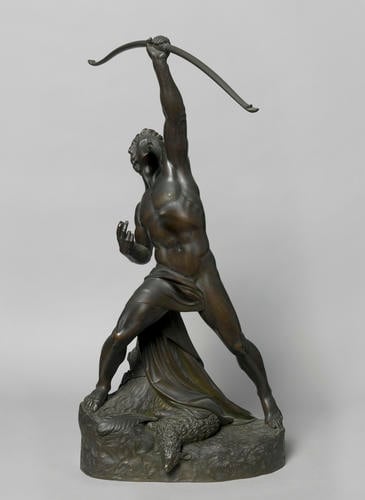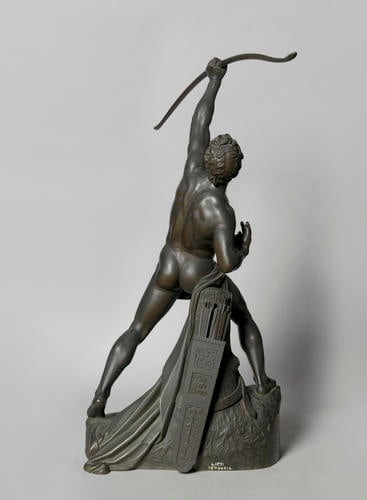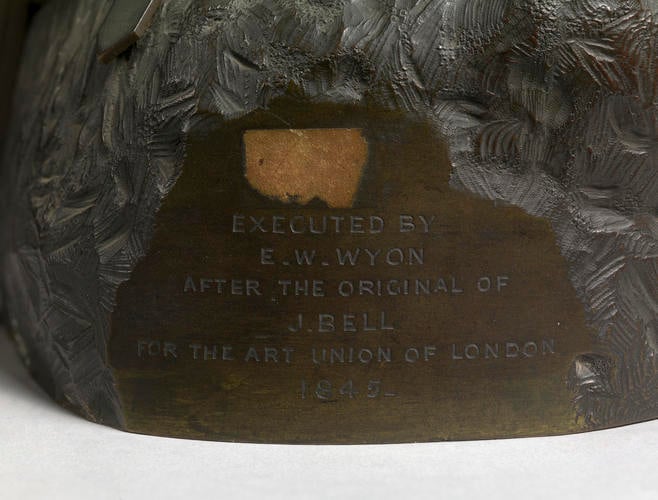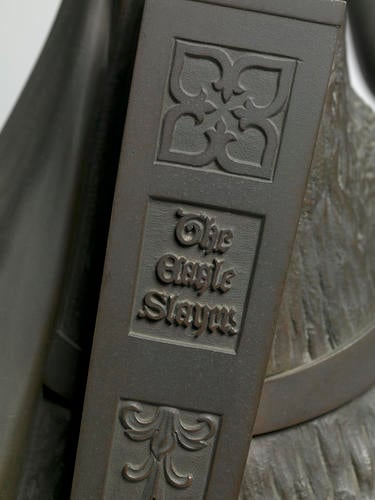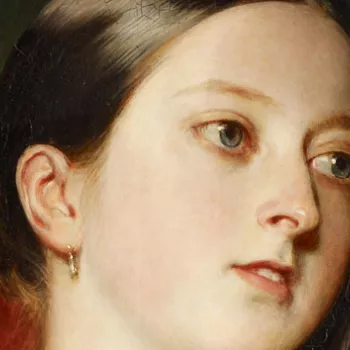The eagle slayer 1845
Bronze | 61.0 x 48.5 x 33.5 cm (whole object) | RCIN 41551
-
One of the most celebrated sculptures in the Great Exhibition of 1851, John Bell’s over-life-size group, The Eagle Slayer (3.5m high) appeared both in bronze and in iron. It had first been exhibited much earlier, in plaster, at the Royal Academy in 1837, and was shown again at Westminster Hall in 1844 in the competitive exhibition for the selection of sculptors for the new Houses of Parliament. By this time a marble version had been commissioned by Earl Fitzwilliam for Wentworth Woodhouse. At the conclusion of the Great Exhibition the Coalbrookdale iron cast was presented by the sculptor to the Commission for the Exhibition, and stood for some years in the Staircase Hall of Kensington Palace. The subject, a shepherd wreaking revenge on the bird that has killed the lamb that lies at his feet, was illustrated in a poem by the sculptor himself: ‘Bare to the mountain blast And ever bounding fast, His glances upward flang, His quiver 'hind him cast, For vengeance on the bird Swift up the mountain-side he past, By love and anger spurred; Aloft he shakes his bow, Thanatos to Aeto [Death of the eagle].’ To Victorian eyes this was an essentially neoclassical subject, a mortal struggling to avenge a sudden vicious act by an eagle - the symbol of Jupiter. It is strikingly similar to the theme of an opera by Franz Joseph Gläser (1798-1861), Des Adlers Horst, which was in the repertoire of the Coburg court theatre in the three years prior to Prince Albert's arrival in London and whose overture - ‘one he particularly liked’ - he and the Queen would often play fourhanded on the piano in their first years of marriage (In the opera a man seeks vengeance on an eagle which has stolen his child, in the end saving it from the bird's grasp). Whether or not this resemblance occurred to Prince Albert, the bronze reduction of The Eagle Slayer must also have appealed to him as a product of the Art Union, a remarkable scheme based upon a lottery whereby selected works by numerous different sculptors were cast in editions and distributed to the winners. The aim, as with reductions in Parian ware, was to enable wider appreciation of sculpture and to help sculptors to reach a wider public with their work. The scheme had been started in 1837 at the suggestion of the Select Committee on the Fine Arts. Both ideal works and portrait busts (including reductions of Chantrey's bust of Queen Victoria) were selected as prizes over the years and in 1845 it was the turn of The Eagle Slayer. In 1849 the Art Union committee offered to Prince Albert one copy of each of the bronze reductions produced up to that date under the scheme. They were placed at Osborne, where they remain. John Bell was born in Norfolk and moved to London in 1827 to study drawing. He enrolled in the Royal Academy Schools as a sculptor the following year. At the peak of his success he was in demand for a great variety of work, from ornamental models to monumental outdoor groups and figures in London, including the Crimea Guards Memorial in Waterloo Place (1859) and the group of ‘America’ for the Albert Memorial in Kensington (1871). His other successful exhibit at the Great Exhibition, Andromeda, cast in bronze by the Coalbrookdale Company in 1851, was purchased by the Queen to be the centrepiece of a fountain on the lower terrace at Osborne. E.W. Wyon, the son of Thomas Wyon, chief engraver of the seals, was born into a dynasty of medallists but made his career as a sculptor on a large scale. He was often employed by the Art Union to create reductions of works by other sculptors. Text from Victoria & Albert: Art & Love.
Provenance
Presented to Prince Albert in 1849 by the Art Union. Over life-size originals in bronze and iron exhibited in the 1851 Great Exhibition for Fine Arts Class 30 and as example of casting by the Coalbrookdale Company.
-
Creator(s)
(sculptor)(publisher)(nationality)Acquirer(s)
-
Medium and techniques
Bronze
Measurements
61.0 x 48.5 x 33.5 cm (whole object)
Category
Object type(s)




